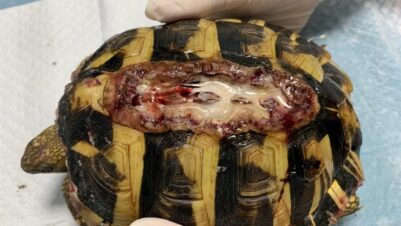Initially derived from traditional Chinese medicine, acupuncture was rarely used for small animals in the UK until interest in the technique rose in the last 20 years. Nowadays, research in small animal veterinary medicine is looking at acupuncture as a complementary or alternative treatment option for certain conditions, particularly for additional pain management.
Current schools of thought
There are two schools for veterinary acupuncture: the traditional Chinese medicine (TCM) approach and Western veterinary acupuncture.
The TCM approach is based on ancient concepts – such as “Qi”(loosely translated as “vital force” or “life energy”), yin and yang, and the five elements – and on hundreds of years of clinical observation without the current knowledge and understanding of biology. Hence why, once translated (sometimes approximately), this can appear confusing for “Western-trained” veterinarians and has previously led to scepticism and mistrust of acupuncture. The Western approach is based on anatomy (musculoskeletal, fascial and nervous systems) and neurophysiological effects. It aims to rely on sound scientific evidence, which is more appealing to the Western audience.
The two schools are conceptually opposite; however, as science progresses, the resulting diagnoses and treatments chosen by the two schools often appear to be similar (Wright, 2021).
What is veterinary acupuncture?

Acupuncture treatment uses very fine needles (Figure 1) inserted into specific points in the body called acupuncture points or acupoints. These often lie in highly innervated and vascularised regions (eg arterioles, venules and lymphatic vessels) or where peripheral nerves surface between two fascial planes. A higher concentration of transient receptor potential vanilloid type 1 (TRPV1), a receptor implicated in pain transmission, has been observed in the receptive fields of acupuncture points (Dewey and Xie, 2021).
Acupoints are mapped over the body along “meridians”. There are 12 meridians, paired and symmetrical, and two on the midline: one ventrally and one dorsally. Both schools of acupuncture use the same maps, which allows easy communication and understanding between acupuncturists. Interestingly, when we superimpose anatomical drawings of the myofascial system onto maps of acupuncture meridians, there are many similarities (Myers, 2014). This is one of the points of convergence between the TCM and Western approaches.
Other types of acupuncture, such as moxibustion, aquapuncture and bee venom acupuncture, are less commonly used in small animal medicine. However, laser acupuncture has recently gained some momentum, due to the easy access to laser therapy in many vet practices. Electroacupuncture involves linking some needle pairs with wires to stimulate the local area using a small electrical current (Figure 2). This is thought to have a more profound, longer-lasting effect than other types of acupuncture (Dewey and Xie, 2021).

How does acupuncture work?
The effects of acupuncture arise from (Steiss, 2000):
- Stimulation of the peripheral nervous system via free nerve endings
- Mechanotransduction through modification of the shape of the fascia and muscle fibres
- Local microtrauma causing release of inflammatory mediators, such as bradykinin, histamine and nitric oxide
These result in local, segmental and systemic effects.
Locally, hyperaemia and vasodilation are observed, together with muscular relaxation and modulation of the immune system (Steiss, 2000). Some studies even suggest a local inhibition of the cyclo-oxygenase-2 (COX-2) and prostaglandin E2 (PGE2) pathway and a decrease in nerve growth factor (NGF) expression (Dewey and Xie, 2021).
There is downregulation of neuromediators, such as calcitonin gene-related peptide and substance P, and reduced N-methyl-D-aspartate receptor (NMDA) activity in the dorsal horn and segmental levels of the spinal cord (Steiss, 2000; Dewey and Xie, 2021). This reduces the transmission of nociceptive signals and downregulates the ascending excitatory pathways. Release of other neurotransmitters, such as brain-derived neurotrophic factor, may have positive effects on neuroplasticity and nerve repair.
Systemic effects of acupuncture include the release of endogenous opioids and simulation or restoration of the descending inhibition pathways via activation of specific regions in the brain (Dewey and Xie, 2021; Steiss, 2000). Acupuncture also has some effects on the autonomic nervous system, such as reduced heart rate and increased intestinal motility, and endocrine systems, including serotonin, oxytocin, dopamine and noradrenalin release (Steiss, 2000).
What is the evidence for acupuncture in veterinary practice?
Currently, acupuncture is mostly used as an adjunct to pharmaceutical treatment of pain in small animals (Baker-Meuten et al.,2020).
One barrier preventing the use of acupuncture in veterinary practice is the presumed lack of evidence. There is limited evidence of efficacy in small animals, although some studies have been published recently (Chomsiriwat and Ma, 2019; Baker-Meuten et al.,2020; Lane and Hill, 2016; Teixeira et al., 2016). Most publications to date are case reports, with a limited number of good-quality randomised controlled trials (Rose et al., 2017). However, there is a wealth of evidence from human medicine and laboratory animals, with at least one review finding a high level of evidence towards efficacy in chronic pain (Vickers et al., 2018).
Treating acute pain
In regard to acute pain, some studies have looked at acupuncture as part of a multimodal anaesthesia/analgesia protocol in the immediate pre- or post-operative period:
- Machin et al. (2020) tested the efficacy of one preoperative acupuncture treatment (under anaesthesia) on dogs undergoing thoracolumbar hemilaminectomy. The group receiving acupuncture needed less fentanyl administration perioperatively; there was no difference between groups post-operatively
- Hammond (2023) performed a randomised controlled trial on dogs underdoing elective procedures. One group received electroacupuncture (EA) for 20 minutes during the procedure, while the control group did not. The EA group had a shorter recovery time, and there was a trend towards lower pain scores at one to two hours post-operation, although this was not statistically significant. The author suggested that a longer duration of EA treatment prior to surgery may have been more efficacious. This study was also underpowered, particularly as it comprised two different surgical procedures (castration and spay) with different analgesia requirements
- More generally, recent research suggests a mild analgesic effect of acupuncture (or electroacupuncture) when used around surgery (Groppetti et al., 2011)
Treating chronic pain
Chronic pain is maladaptive, with neuroplasticity turning towards pain facilitation, central sensitisation and downregulation of descending inhibition pathways. As per its mechanism of action, acupuncture may be beneficial in this situation as it helps to restore descending inhibition and promote neuroplasticity towards a more balanced transmission of nociceptive signals (Figure 3).

A few studies have shown that acupuncture improves client-specific outcome measures (CSOM) and validated pain scores, as well as quality of life in small animals suffering from chronic painful conditions (Baker-Meuten et al., 2020; Lane and Hill, 2016; Teixeira et al., 2016):
- Teixeira et al. (2016) conducted a randomised controlled trial on dogs with hip dysplasia, comparing acupuncture weekly for a month to treatment with carprofen or placebo. There was a significant improvement in pain scores in favour of acupuncture when compared to placebo, without improvement of lameness assessed by walking on a force-plate
- Baker-Meuten et al.(2020) found similar results, with improvements in some CSOM for dogs treated with acupuncture for osteoarthritis pain, but no difference in lameness or orthopaedic examination. Interestingly, 58 percent of the owners guessed the treatment phase correctly (acupuncture versus placebo)
As often in veterinary medicine, larger studies are required to confirm the efficacy of acupuncture and the protocols to use in cases of acute and chronic pain.
What are the challenges for scientific research on acupuncture in veterinary practice?
Clinical research in small animal acupuncture is, indeed, difficult to implement rigorously. The expected efficacy of acupuncture is usually a mild improvement in analgesia, which means large cohorts of pets are needed. Ethical concerns prevent the use of acupuncture alone, hence the need to offer the option of rescue analgesia or to continue with current medications, which renders the effects of acupuncture less obvious or easy to prove. Equally, acupuncture is meant to be tailored to the individual animal, and thus standard protocols are less likely to yield a positive outcome. Caregiver placebo effect may interfere with the results in pain scores. Blinding can be challenging as owners may recognise when the animals have had a treatment even if they are not present (Baker-Meuten et al.,2020).
In order to advance the research in veterinary medicine, we may need to consider collaborative work for large multicentre studies to produce high-quality randomised controlled trials and clarify which protocols are efficacious for which condition.
What happens during acupuncture treatment?
Practically, acupuncture treatments involve inserting several needles (up to 30) in acupoints chosen after an examination of the pet. These points are adapted at each session. Treatments are repeated regularly, usually weekly but occasionally twice weekly or even daily. A treatment typically lasts between 5 and 30 minutes (Altam, 2000; Baker-Meuten et al., 2020). Clinically, the effects of acupuncture appear to build up over time, which means that treatments are gradually spaced out (at four- to six-week intervals, for example).
During the treatment, minimal restraint is needed to keep the pet calm. The presence of the owner is often required and beneficial to maintain a reassuring environment. Treats may be used to create a distraction while inserting the needles, and most pets will accept the treatment well. In the author’s experience, most dogs (and some cats!) appear to relax or even fall asleep during treatment. However, if the patient is needle-shy, or experiencing too much pain, laser acupuncture may be a good alternative when used alone or in combination with dry needle acupuncture (Chomsiriwat and Ma, 2019).
What are the contraindications, adverse effects and precautions of acupuncture in small animals?
There are few contraindications for acupuncture treatment. One should avoid needle insertion in and around infected skin, unstable fractures and neoplasms and in patients with bleeding disorders. Electroacupuncture should not be used on pregnant females, on patients with severe heart disease and implanted pacemakers, or over the head and cervical region (Altam, 2000; Huntingford and Petty, 2022).
Adverse effects and risks of acupuncture treatment are few and limited: the most serious concern is the ingestion of a needle by the pet. There is one published case report of a cat swallowing a needle, who eventually passed the needle without further consequences (O’Leary, 2015). To prevent this, the animal must be under constant supervision during treatment and needles counted before and after treatment. Perforation of a body cavity is a risk that is mitigated by the skill of the therapist and excellent knowledge of anatomy.
Minor adverse effects include bleeding, bruising or pain on the insertion and/or removal of a needle. Here, the skill of the acupuncturist plays a great role, with the risks minimised by a tailored choice of acupoints and ensuring a swift needle insertion in the right anatomical location (Altam, 2000). In rare cases, a worsening of the pain state for 24 to 48 hours has been described. This may be due to needling of a myofascial trigger point and is usually short-lived. Mild sedation after treatment is common and is not normally cause for concern. Risks of infection or needle breaking are extremely rare nowadays, due to the use of human-grade sterile single-use needles.
Conclusion
Acupuncture remains a topic for heated debate among veterinary professionals, with strongly biased views for and against it as a therapy. As vets, we are culturally more inclined to accept a new drug available on the market than to consider acupuncture as a potential treatment option. A recent shift in this mindset has allowed emergence of acupuncture as another “tool in the box” for the multimodal management of pain. Indeed, if strong evidence for the efficacy of acupuncture is still lacking, anecdotal reports and recent studies suggest a positive effect on pain and quality of life in small animals.
Side effects remain minimal compared to pharmaceutical treatments. This should at least convince vets to “give it a try”. As acupuncture becomes more mainstream, this should, in turn, support good-quality clinical research to provide a stronger evidence base for its efficacy in a variety of conditions.








